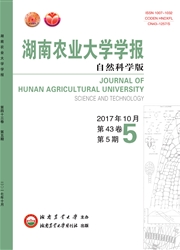

 中文摘要:
中文摘要:
分别选用实生苗阶段不同丛有效茎水平品系120份和28个杂交组合不同成苗数实生苗840份作为试验材料,研究实生苗无性繁殖后出苗率、有效茎、丛有效茎和芽成茎数4个芽成茎指标在品系间和水平间的差异及广义遗传力,以及实生苗成苗数、成茎数和成茎率的广义遗传力和遗传相关。结果表明:无性繁殖后出苗率和有效茎数、丛有效茎数、芽成茎数的品系间和水平间差异均达极显著水平,其广义遗传力分别为0.58、0.65、0.84和0.84;实生苗阶段丛有效茎数≥5的品系芽成茎指标总体显著高于4条及以下的品系,且主要为强丛生性品系,占61.29%以上;实生苗成苗数和丛有效茎数组合间的差异极显著,其广义遗传力分别为0.67和0.76,成苗数和丛有效茎数的遗传相关性达极显著水平;不同成苗水平实生苗丛有效茎间的差异极显著,丛有效茎数随成苗数的增加而显著增加;成苗数≥7的实生苗仅占30.24%,丛有效茎数≥5的实生苗仅占13.81%。
 英文摘要:
英文摘要:
A total of 120 clones with various millable stalks per stool (MSS) at seedling stage and 840 seedlings from 28 families were selected as materials which were respectively planted at two field experiment sties. The broad heritability (h2) and genetic correlations between the number of tillers and MSS were researched based on indices from vegetative propagation of seedlings, including germination rate, the number of millable stalks, MSS and millable stalks per bud (MSB). The results showed that there were very significant differences among germination rate, millable stalks, MSS and MSB whether in genotypes or in levels at seedling stage after vegetative propagation, with an h2 of 0.58, 0.65, 0.84 and 0.84, respectively; The clones with MSS equal or larger than 5 at seedling stage were significantly higher than that of equal or less than 4 in general, and 61.29% of these clones generated MSB equal or larger than 3 at vegetative crop; There were very significant difference in the aspect of genetic correlations among the combinations of the number of tillers and MSS with an h2 of 0.67 and 0.76, respectively; The MSS of seedlings were significantly increased with thelevel of tillers, and the seedlings with tillers equal or larger than 7 accounted for 30.24%, by contrast, MSS equal or larger than 5 only accounted for 13.81%.
 同期刊论文项目
同期刊论文项目
 同项目期刊论文
同项目期刊论文
 期刊信息
期刊信息
